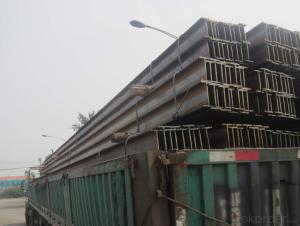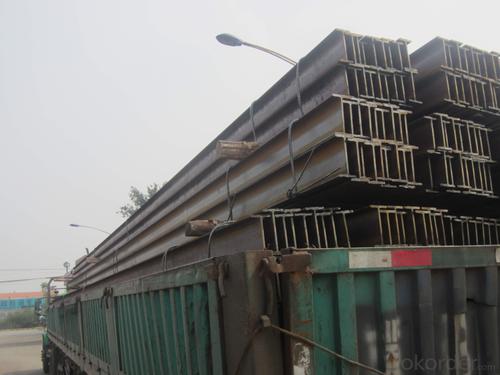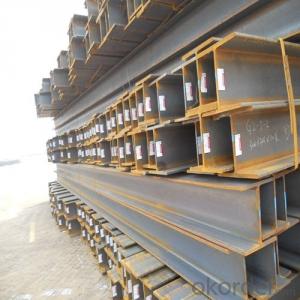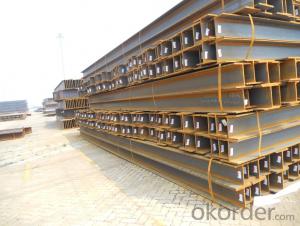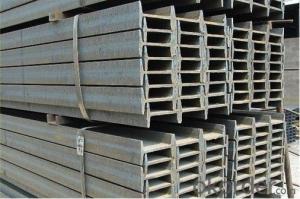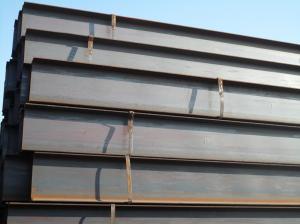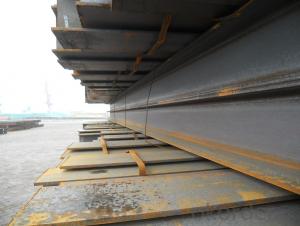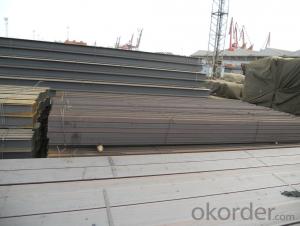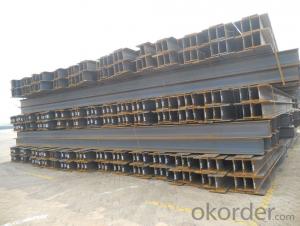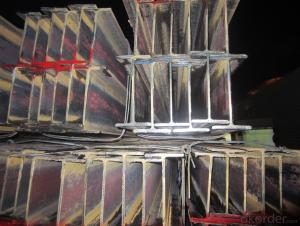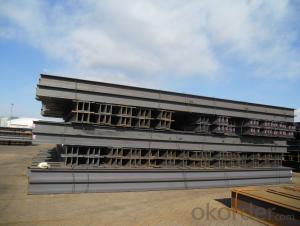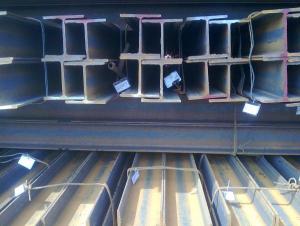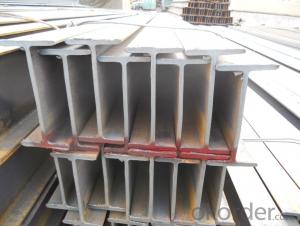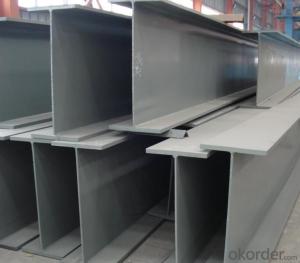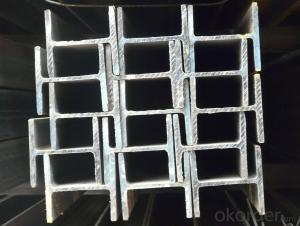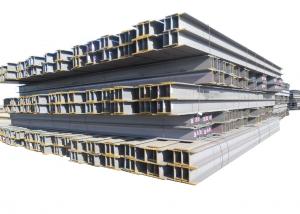High Quality Hot Rolled Jis Standard Steel H Beam
- Loading Port:
- Tianjin
- Payment Terms:
- TT OR LC
- Min Order Qty:
- 25 m.t.
- Supply Capability:
- 1000 m.t./month
OKorder Service Pledge
OKorder Financial Service
You Might Also Like
roduct Description:
Specifications of Hot Rolled Steel H-beam
1. Standard: GB
2. Grade: Q235 or Equivalent
3. Length: 6m,10m, 12m as following table
4. Invoicing on theoretical weight or actual weight as customer request
5.Payment: TT or L/C
6. Sizes:
Category | model (height*width)/ (mm×mm) | Section size/mm | Cross-section area/cm2 | Theoretical Weight/(kg/m) | Moment of inertia/cm4 | radius/cm | Section modulus/cm3 | |||||||
H | B | t1 | t2 | r | Ix | Iy | ix | iy | Wx | Wy | ||||
HW | 100×100 | 100 | 100 | 6 | 8 | 8 | 21.59 | 16.9 | 386 | 134 | 4.23 | 2.49 | 77.1 | 26.7 |
125×125 | 125 | 125 | 6.5 | 9 | 8 | 30.00 | 23.6 | 843 | 293 | 5.30 | 3.13 | 135 | 46.9 | |
150×150 | 150 | 150 | 7 | 10 | 8 | 39.65 | 31.1 | 1620 | 563 | 6.39 | 3.77 | 216 | 75.1 | |
175×175 | 175 | 175 | 7.5 | 11 | 13 | 51.43 | 40.4 | 2918 | 983 | 7.53 | 4.37 | 334 | 112 | |
200×200 | 200 | 200 | 8 | 12 | 13 | 63.53 | 49.9 | 4717 | 1601 | 8.62 | 5.02 | 472 | 160 | |
200 | 204 | 12 | 12 | 13 | 71.53 | 56.2 | 4984 | 1701 | 8.35 | 4.88 | 498 | 167 | ||
250×250 | 244 | 252 | 11 | 11 | 13 | 81.31 | 63.8 | 8573 | 2937 | 10.27 | 6.01 | 703 | 233 | |
250 | 250 | 9 | 14 | 13 | 91.43 | 71.8 | 10689 | 3648 | 10.81 | 6.32 | 855 | 292 | ||
250 | 255 | 14 | 14 | 13 | 103.93 | 81.6 | 11340 | 3875 | 10.45 | 6.11 | 907 | 304 | ||
HM | 150×100 | 148 | 100 | 6 | 9 | 8 | 26.35 | 20.7 | 995.3 | 150.3 | 6.15 | 2.39 | 134.5 | 30.1 |
200×150 | 194 | 150 | 6 | 9 | 8 | 38.11 | 29.9 | 2586 | 506.6 | 8.24 | 3.65 | 266.6 | 67.6 | |
250×175 | 244 | 175 | 7 | 11 | 13 | 55.49 | 43.6 | 5908 | 983.5 | 10.32 | 4.21 | 484.3 | 112.4 | |
HN | 100×50 | 100 | 50 | 5 | 7 | 8 | 11.85 | 9.3 | 191.0 | 14.7 | 4.02 | 1.11 | 38.2 | 5.9 |
125×60 | 125 | 60 | 6 | 8 | 8 | 16.69 | 13.1 | 407.7 | 29.1 | 4.94 | 1.32 | 65.2 | 9.7 | |
150×75 | 150 | 75 | 5 | 7 | 8 | 17.85 | 14.0 | 645.7 | 49.4 | 6.01 | 1.66 | 86.1 | 13.2 | |
175×90 | 175 | 90 | 5 | 8 | 8 | 22.90 | 18.0 | 1174 | 97.4 | 7.16 | 2.06 | 134.2 | 21.6 | |
200×100 | 198 | 99 | 4.5 | 7 | 8 | 22.69 | 17.8 | 1484 | 113.4 | 8.09 | 2.24 | 149.9 | 22.9 | |
200 | 100 | 5.5 | 8 | 8 | 26.67 | 20.9 | 1753 | 133.7 | 8.11 | 2.24 | 175.3 | 26.7 | ||
250×125 | 248 | 124 | 5 | 8 | 8 | 31.99 | 25.1 | 3346 | 254.5 | 10.23 | 2.82 | 269.8 | 41.1 | |
250 | 125 | 6 | 9 | 8 | 36.97 | 29.0 | 3868 | 293.5 | 10.23 | 2.82 | 309.4 | 47.0 | ||
300×150 | 298 | 149 | 5.5 | 8 | 13 | 40.80 | 32.0 | 5911 | 441.7 | 12.04 | 3.29 | 396.7 | 59.3 | |
300 | 150 | 6.5 | 9 | 13 | 46.78 | 36.7 | 6829 | 507.2 | 12.08 | 3.29 | 455.3 | 67.6 | ||
350×175 | 346 | 174 | 6 | 9 | 13 | 52.45 | 41.2 | 10456 | 791.1 | 14.12 | 3.88 | 604.4 | 90.9 | |
350 | 175 | 7 | 11 | 13 | 62.91 | 49.4 | 12980 | 983.8 | 14.36 | 3.95 | 741.7 | 112.4 | ||
400×150 | 400 | 150 | 8 | 13 | 13 | 70.37 | 55.2 | 17906 | 733.2 | 15.95 | 3.23 | 895.3 | 97.8 | |
HT | 100×50 | 95 | 48 | 3.2 | 4.5 | 8 | 7.62 | 6.0 | 109.7 | 8.4 | 3.79 | 1.05 | 23.1 | 3.5 |
97 | 49 | 4 | 5.5 | 8 | 9.38 | 7.4 | 141.8 | 10.9 | 3.89 | 1.08 | 29.2 | 4.4 | ||
100×100 | 96 | 99 | 4.5 | 6 | 8 | 16.21 | 12.7 | 272.7 | 97.1 | 4.10 | 2.45 | 56.8 | 19.6 | |
125×60 | 118 | 58 | 3.2 | 4.5 | 8 | 9.26 | 7.3 | 202.4 | 14.7 | 4.68 | 1.26 | 34.3 | 5.1 | |
120 | 59 | 4 | 5.5 | 8 | 11.40 | 8.9 | 259.7 | 18.9 | 4.77 | 1.29 | 43.3 | 6.4 | ||
125×125 | 119 | 123 | 4.5 | 6 | 8 | 20.12 | 15.8 | 523.6 | 186.2 | 5.10 | 3.04 | 88.0 | 30.3 | |
150×75 | 145 | 73 | 3.2 | 4.5 | 8 | 11.47 | 9.0 | 383.2 | 29.3 | 5.78 | 1.60 | 52.9 | 8.0 | |
147 | 74 | 4 | 5.5 | 8 | 14.13 | 11.1 | 488.0 | 37.3 | 5.88 | 1.62 | 66.4 | 10.1 | ||
150×100 | 139 | 97 | 4.5 | 4.5 | 8 | 13.44 | 10.5 | 447.3 | 68.5 | 5.77 | 2.26 | 64.4 | 14.1 | |
142 | 99 | 4.5 | 6 | 8 | 18.28 | 14.3 | 632.7 | 97.2 | 5.88 | 2.31 | 89.1 | 19.6 | ||
150×150 | 144 | 148 | 5 | 7 | 8 | 27.77 | 21.8 | 1070 | 378.4 | 6.21 | 3.69 | 148.6 | 51.1 | |
147 | 149 | 6 | 8.5 | 8 | 33.68 | 26.4 | 1338 | 468.9 | 6.30 | 3.73 | 182.1 | 62.9 | ||
175×90 | 168 | 88 | 3.2 | 4.5 | 8 | 13.56 | 10.6 | 619.6 | 51.2 | 6.76 | 1.94 | 73.8 | 11.6 | |
171 | 89 | 4 | 6 | 8 | 17.59 | 13.8 | 852.1 | 70.6 | 6.96 | 2.00 | 99.7 | 15.9 | ||
175×175 | 167 | 173 | 5 | 7 | 13 | 33.32 | 26.2 | 1731 | 604.5 | 7.21 | 4.26 | 207.2 | 69.9 | |
172 | 175 | 6.5 | 9.5 | 13 | 44.65 | 35.0 | 2466 | 849.2 | 7.43 | 4.36 | 286.8 | 97.1 | ||
200×100 | 193 | 98 | 3.2 | 4.5 | 8 | 15.26 | 12.0 | 921.0 | 70.7 | 7.77 | 2.15 | 95.4 | 14.4 | |
196 | 99 | 4 | 6 | 8 | 19.79 | 15.5 | 1260 | 97.2 | 7.98 | 2.22 | 128.6 | 19.6 | ||
200×150 | 188 | 149 | 4.5 | 6 | 8 | 26.35 | 20.7 | 1669 | 331.0 | 7.96 | 3.54 | 177.6 | 44.4 | |
Usage & Applications of Hot Rolled Steel H-beam
Commercial building structure ;Pre-engineered buildings; Machinery support structure; Prefabricated structure; Medium scale bridges; Ship-building structure. etc.
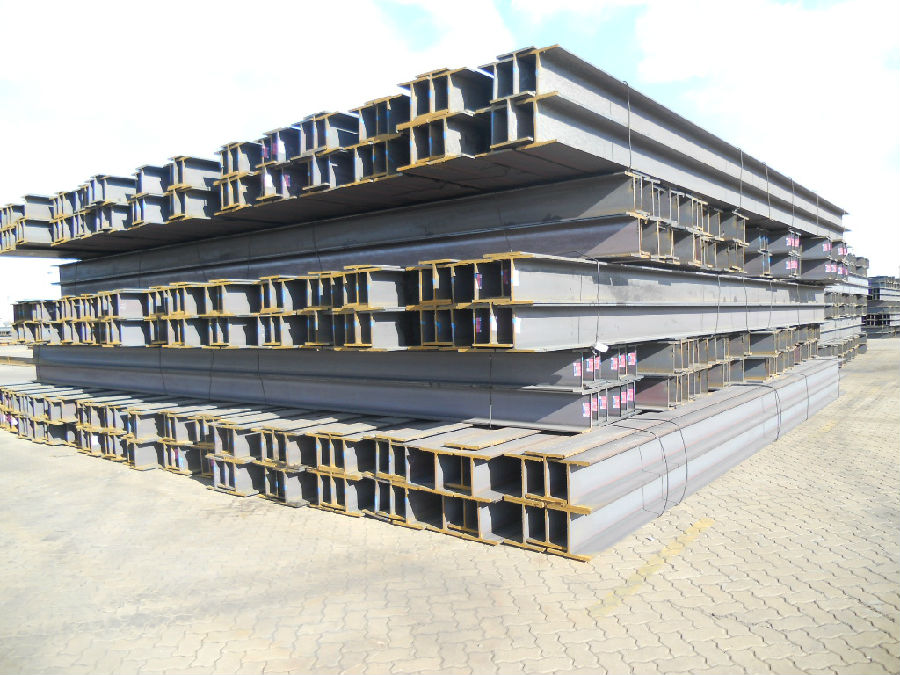
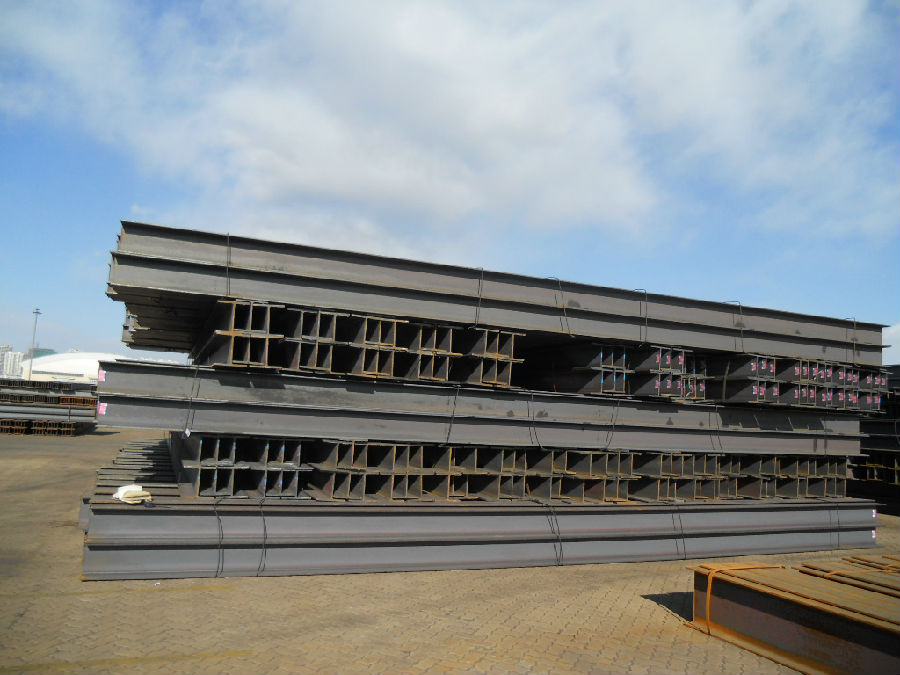
Packaging & Delivery of Hot Rolled Steel H-beam
1. Packing: it is nude packed in bundles by steel wire rod
2. Bundle weight: not more than 3.5MT for bulk vessel; less than 3 MT for container load
3. Marks:
Color marking: There will be color marking on both end of the bundle for the cargo delivered by bulk vessel. That makes it easily to distinguish at the destination port.
Tag mark: there will be tag mark tied up on the bundles. The information usually including supplier logo and name, product name, made in China, shipping marks and other information request by the customer.
If loading by container the marking is not needed, but we will prepare it as customer request.
4. Transportation: the goods are delivered by truck from mill to loading port, the maximum quantity can be loaded is around 40MTs by each truck. If the order quantity cannot reach the full truck loaded, the transportation cost per ton will be little higher than full load.
5. Delivered by container or bulk vessel
Production flow of Hot Rolled Steel H-beam
Material prepare (billet) —heat up—rough rolling—precision rolling—cooling—packing—storage and transportation
- Q: How do steel H-beams contribute to water conservation in buildings?
- Water conservation in buildings is greatly aided by the use of steel H-beams, as they enable the incorporation of sustainable design features like rainwater harvesting systems and efficient plumbing systems. To begin with, the construction of roofs often involves the utilization of steel H-beams, which are ideal for the installation of rainwater harvesting systems. These systems gather and store rainwater that can be utilized for various non-potable purposes, including toilet flushing, irrigation, and cooling. By utilizing rainwater instead of potable water for these tasks, steel H-beams indirectly aid in water conservation by reducing the demand for fresh water. Moreover, steel H-beams are crucial for the construction of water-efficient plumbing systems. These systems can integrate elements such as low-flow fixtures, dual-flush toilets, and sensor-activated faucets. These water-saving fixtures help minimize water consumption by reducing the amount of water used per flush or per use. Steel H-beams provide the necessary structural support to incorporate these sustainable plumbing features into building designs. Furthermore, steel H-beams possess exceptional durability and longevity, thus reducing the need for frequent repairs or replacements. This durability minimizes water wastage caused by leaks or damages to the building structure. By ensuring the stability and integrity of the building, steel H-beams actively contribute to water conservation by preventing water damage and subsequent water loss. To summarize, steel H-beams greatly aid in water conservation within buildings by enabling the installation of rainwater harvesting systems, supporting water-efficient plumbing systems, and providing structural durability to prevent water wastage. By incorporating these sustainable design features, steel H-beams assist in reducing the demand for fresh water and promoting responsible water usage in buildings.
- Q: Can steel H-beams be used in airport hangar or aircraft maintenance facilities?
- Yes, steel H-beams can be used in airport hangars or aircraft maintenance facilities. Steel H-beams are versatile structural elements that offer excellent strength-to-weight ratio and load-bearing capabilities. They are commonly used in construction projects that require large open spaces, such as aircraft hangars and maintenance facilities. The H-shaped design of the beams provides structural rigidity and stability, making them suitable for supporting heavy loads and withstanding the dynamic forces associated with aircraft operations. Additionally, steel H-beams can be easily fabricated and installed, allowing for efficient construction and customization to meet specific design requirements. Overall, steel H-beams are a popular choice in the aviation industry due to their strength, durability, and versatility.
- Q: How do steel H-beams perform in terms of impact resistance?
- The excellent impact resistance of Steel H-beams is well-known. Their structural design, characterized by wide flanges and a vertical web, ensures high durability and strength when exposed to impact forces. This feature makes them particularly suitable for applications where heavy loads or potential impacts are a concern, such as in construction projects or industrial settings. The wide flanges of H-beams distribute the impact load across a larger area, minimizing concentrated stress points and preventing failure. Moreover, the vertical web provides added rigidity and stability, enhancing the overall resistance of the beam against impacts. Additionally, steel possesses inherent toughness and resilience as a material, enabling it to absorb and dissipate energy from impacts effectively. Steel H-beams are often manufactured using top-quality structural steel, further enhancing their impact resistance properties. To summarize, the structural design of steel H-beams, combined with the material properties of steel, results in excellent impact resistance. They can withstand heavy loads and potential impacts, making them a dependable choice for a variety of applications that require structural strength and durability.
- Q: How do steel H-beams perform in areas with high humidity and chemical exposure?
- Steel H-beams are known for their exceptional strength and durability, making them a popular choice for various structural applications. However, when it comes to areas with high humidity and chemical exposure, there are a few factors to consider. In general, steel is highly resistant to humidity and can withstand prolonged exposure without significant degradation. The H-beams' design, with its wide flanges and thick web, contributes to their resistance against moisture and corrosion. The flanges act as a protective barrier, preventing direct contact between the steel and the surrounding environment. Additionally, the steel used in H-beams is typically coated with a protective layer, such as galvanized or painted coatings, further enhancing its resistance to humidity and chemicals. However, it is important to note that prolonged exposure to high humidity and certain aggressive chemicals can still have an impact on the performance of steel H-beams. In extremely corrosive environments, the protective coating may deteriorate over time, leaving the steel vulnerable to rust and corrosion. This can weaken the structural integrity of the beams and compromise their performance. To mitigate these risks, regular maintenance and inspections are essential. In areas with high humidity and chemical exposure, it is recommended to implement a robust maintenance plan that includes periodic cleaning, inspection for any signs of corrosion, and reapplication of protective coatings as needed. Additionally, using stainless steel H-beams instead of carbon steel ones can provide even greater resistance to corrosion in such environments. In summary, while steel H-beams generally perform well in areas with high humidity and chemical exposure, proper maintenance and inspection are crucial to ensure their long-term durability. By implementing a proactive maintenance plan, the structural integrity of the beams can be preserved, ensuring their continued performance in challenging environments.
- Q: What are the installation requirements for steel H-beams?
- The installation process for steel H-beams depends on several factors, including the application, load requirements, and structure design. However, there are general guidelines that can be followed. 1. Approval from a Structural Engineer: Before installing steel H-beams, it is crucial to seek the approval of a structural engineer who can evaluate the project's specific requirements and authorize the installation. 2. Preparation of the Site: The ground where the H-beams will be installed must be adequately prepared. This may involve clearing obstructions, leveling the ground, and establishing a stable foundation. 3. Lifting and Handling: Steel H-beams are heavy and require appropriate equipment like cranes or forklifts for lifting and positioning. Safety precautions must be followed during this process. 4. Alignment and Leveling: It is essential to ensure precise alignment and leveling of the H-beams according to the design specifications during installation. Laser levels or other alignment tools can assist in achieving this. 5. Connection Methods: H-beams are typically connected to other structural members using welding, bolting, or a combination of both. The specific method depends on design requirements and load considerations. 6. Welding: Certified welders should perform welding connections, adhering to industry standards and guidelines. Proper techniques, including pre-heating and post-welding inspections, ensure structural integrity. 7. Bolting: Connections made using bolts should utilize appropriate grade bolts and nuts. The engineer's torque specifications should be followed to achieve the required connection strength. 8. Bracing and Temporary Supports: Temporary supports or bracing may be necessary during installation to hold the H-beams in place until permanent connections are made. These supports must be designed and installed correctly for safety. 9. Inspection and Quality Control: Regular inspections should be conducted during installation to ensure compliance with all requirements and proper installation of the H-beams. Quality control measures must be implemented to identify any defects or deviations from design specifications. It is important to note that the installation requirements for steel H-beams can vary depending on the specific project and engineering requirements. Therefore, consulting a qualified engineer or contractor is recommended to receive detailed guidance and ensure a safe and efficient installation process.
- Q: Can steel H-beams be used in solar panel installations?
- Indeed, it is possible to incorporate steel H-beams into solar panel installations. These H-beams are widely employed in construction due to their robustness and capacity to sustain substantial burdens. In terms of solar panel installations, H-beams serve as the fundamental support system for the mounting of solar panels. Consequently, they guarantee stability and endurance, ensuring the panels remain steadfastly in position even during unfavorable weather circumstances. Furthermore, steel H-beams exhibit a resistance to corrosion, a crucial attribute for outdoor applications such as solar panel installations. On the whole, steel H-beams represent a dependable and frequently employed choice for the mounting of solar panels.
- Q: Can steel H-beams be used in industrial manufacturing facilities?
- Yes, steel H-beams are commonly used in industrial manufacturing facilities due to their high strength and load-bearing capacity. They are often used as structural support beams, providing stability and durability to the facility's infrastructure.
- Q: What are the different types of steel H-beam connections for structures with high seismic activity?
- Ensuring the strength and stability of connections between steel H-beams is crucial in structures located in areas with high seismic activity. Various types of connections are commonly used to provide the necessary strength and stability: 1. Welded Connection: Welding is a popular method for connecting steel H-beams in seismic structures. By fusing the ends of the beams together using heat and pressure, welded connections offer high strength and rigidity, making them suitable for withstanding seismic forces. However, proper welding techniques and inspections are essential to maintain the integrity of the connection. 2. Bolted Connection: Bolted connections involve using bolts and nuts to join the steel H-beams. This method allows for easy assembly and disassembly, making it ideal for structures that may require future modifications. To enhance the seismic performance of bolted connections, high-strength bolts and appropriate washers are used. Bolts are tightened according to specific torque requirements to ensure proper clamping force. Regular inspection and maintenance are necessary to prevent loosening of the bolts over time. 3. Moment-Resisting Connection: This type of connection is specifically designed to resist the rotational forces (moments) generated during an earthquake. Moment-resisting connections can be achieved using various techniques, such as welding, bolted flange plate connections, or end-plate connections. These connections provide enhanced stiffness and strength, enabling the structure to effectively distribute seismic forces. 4. Shear Plate Connection: Shear plate connections involve using steel plates to connect the H-beams. These plates are typically welded to the flanges of the H-beams. Shear plate connections offer excellent resistance against lateral forces and can be designed to accommodate both shear and moment forces. Due to their good energy dissipation capabilities, they are commonly used in seismic structures. 5. Composite Connection: Composite connections involve connecting steel H-beams to other structural elements, such as concrete slabs or columns. By utilizing the combined strength and stiffness of steel and concrete, composite connections enhance seismic resistance. These connections can be achieved through various methods, including welding, bolting, or using connectors specifically designed for composite structures. It is important to carefully analyze and consider engineering factors when selecting the appropriate steel H-beam connection for structures located in areas with high seismic activity. Factors such as the magnitude of seismic forces, structural design requirements, and local building codes should be taken into account to ensure the safety and performance of the overall structure.
- Q: Can steel H-beams be used for shopping centers?
- Yes, steel H-beams can be used for shopping centers. Steel H-beams are commonly used in commercial construction, including shopping centers, due to their strength, durability, and ability to support heavy loads.
- Q: What is the fire rating of steel H-beams?
- The fire rating of steel H-beams typically depends on various factors such as the size and thickness of the beam, the type and thickness of any fire-resistant coatings or treatments applied to the beam, and the overall fire protection system in place. Generally, steel is considered to have inherent fire-resistant properties compared to other building materials such as wood. However, without additional fire protection measures, steel H-beams can lose their load-bearing capacity in high temperatures due to thermal expansion and structural deformation. To improve the fire resistance of steel H-beams, fire protection measures can be implemented, including fire-resistant coatings or fireproofing materials that are applied to the surface of the beams. These coatings or materials are designed to provide a certain level of fire resistance by retarding the heat transfer and delaying the point at which the steel reaches its critical temperature. The fire rating assigned to steel H-beams will depend on the specific fire protection measures employed. Fire ratings are typically expressed in terms of time, such as 30 minutes, 60 minutes, 90 minutes, or 120 minutes, indicating the duration for which the steel beams can withstand fire exposure without significant loss of structural integrity or load-bearing capacity. It is essential to consult with fire protection engineers, architects, and relevant building codes or standards to determine the appropriate fire rating for steel H-beams in a specific application.
Send your message to us
High Quality Hot Rolled Jis Standard Steel H Beam
- Loading Port:
- Tianjin
- Payment Terms:
- TT OR LC
- Min Order Qty:
- 25 m.t.
- Supply Capability:
- 1000 m.t./month
OKorder Service Pledge
OKorder Financial Service
Similar products
Hot products
Hot Searches
Related keywords
